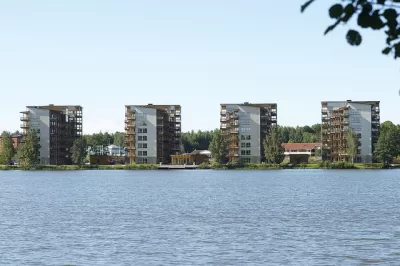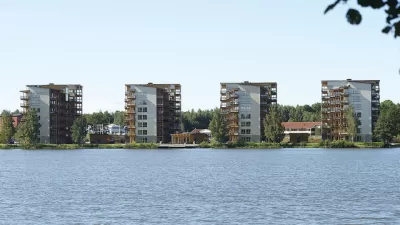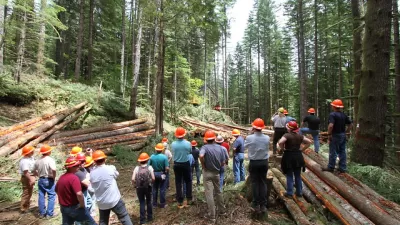Building with wood is back in fashion, but lumber producers have to reckon with thorny politics and new timber-based materials that have yet to be truly defined.

Matthew Messner reviews the history and politics of wood as a building material in a special timber issue of The Architect's Newspaper:
“Over the past 150 years, the process and politics of wood have shaped a highly efficient industry that still provides the vast majority of the U.S.’s house-building material. With new technology, wood is pushing into new territories, and the lumber industry is bracing to respond to these demands.”
Anyone following developments in the built environment has seen the re-rise of wood construction. Timber towers are going up in France, in England, and most recently, “an academic and professional collaboration” produced a timber-based design for the River Beech Tower in Chicago, in part because “it is lighter, more easily transportable and has a smaller environmental impact than its concrete or steel counterparts.”
“Although the lumber industry is confident it can handle an increase in demand,” Messner writes, “there are factors that will need to be addressed.” These include political maneuvering between the U.S. and Canada, updating fire codes, and establish legal definitions for new products like cross-laminated timber (“a true wonder material,” maybe).
FULL STORY: The lumber industry looks to respond to the rise of mass timber

Alabama: Trump Terminates Settlements for Black Communities Harmed By Raw Sewage
Trump deemed the landmark civil rights agreement “illegal DEI and environmental justice policy.”

Planetizen Federal Action Tracker
A weekly monitor of how Trump’s orders and actions are impacting planners and planning in America.

Why Should We Subsidize Public Transportation?
Many public transit agencies face financial stress due to rising costs, declining fare revenue, and declining subsidies. Transit advocates must provide a strong business case for increasing public transit funding.

Understanding Road Diets
An explainer from Momentum highlights the advantages of reducing vehicle lanes in favor of more bike, transit, and pedestrian infrastructure.

New California Law Regulates Warehouse Pollution
A new law tightens building and emissions regulations for large distribution warehouses to mitigate air pollution and traffic in surrounding communities.

Phoenix Announces Opening Date for Light Rail Extension
The South Central extension will connect South Phoenix to downtown and other major hubs starting on June 7.
Urban Design for Planners 1: Software Tools
This six-course series explores essential urban design concepts using open source software and equips planners with the tools they need to participate fully in the urban design process.
Planning for Universal Design
Learn the tools for implementing Universal Design in planning regulations.
Caltrans
Smith Gee Studio
Institute for Housing and Urban Development Studies (IHS)
City of Grandview
Harvard GSD Executive Education
Toledo-Lucas County Plan Commissions
Salt Lake City
NYU Wagner Graduate School of Public Service





























